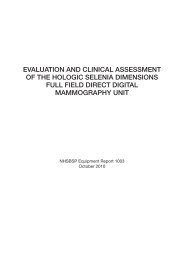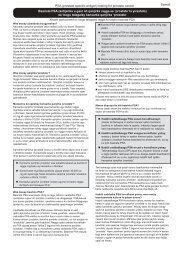reporting lesions in the nhs bowel cancer screening programme
reporting lesions in the nhs bowel cancer screening programme
reporting lesions in the nhs bowel cancer screening programme
You also want an ePaper? Increase the reach of your titles
YUMPU automatically turns print PDFs into web optimized ePapers that Google loves.
3.7 Serrated adenomas<br />
Report<strong>in</strong>g Lesions <strong>in</strong> <strong>the</strong> NHS Bowel Cancer Screen<strong>in</strong>g Programme | 7<br />
These <strong>lesions</strong> have <strong>the</strong> morphology of hyperplastic polyps, namely a serrated epi<strong>the</strong>lial surface<br />
with abundant eos<strong>in</strong>ophilic cytoplasm, but <strong>the</strong>y show def<strong>in</strong>ite dysplasia throughout <strong>the</strong> lesion.<br />
3.8 Mixed hyperplastic/adenomatous polyps<br />
These <strong>lesions</strong> have both non-dysplastic hyperplastic type epi<strong>the</strong>lium show<strong>in</strong>g a serrated glandular<br />
architecture and areas of adenomatous dysplastic epi<strong>the</strong>lium. The two phenotypes are morphologically<br />
dist<strong>in</strong>ct, and, although <strong>the</strong>y may <strong>in</strong>term<strong>in</strong>gle, <strong>in</strong>dividual glandular structures show<strong>in</strong>g both<br />
patterns are not present.<br />
3.9 O<strong>the</strong>r types<br />
3.9.1 Inflammatory polyps<br />
Experience from NHS BCSP pilot sites has shown that <strong>in</strong>flammatory type polyps are relatively<br />
common. Although <strong>the</strong>y are most usually seen as a complication of chronic <strong>in</strong>flammatory <strong>bowel</strong><br />
disease, particularly ulcerative colitis, <strong>the</strong>y are also seen <strong>in</strong> association with diverticulosis, mucosal<br />
prolapse and at <strong>the</strong> site of ureterosigmoidostomy. Fur<strong>the</strong>rmore, sporadic s<strong>in</strong>gle <strong>in</strong>flammatory type<br />
polyps are well described <strong>in</strong> <strong>the</strong> colorectum. As <strong>the</strong> <strong>report<strong>in</strong>g</strong> pathologist may not know <strong>the</strong> true context<br />
of such polyps, we recommend that all such polyps are classified as ‘<strong>in</strong>flammatory polyp’.<br />
3.9.2 Juvenile polyps<br />
Classical juvenile polyps are spherical <strong>in</strong> shape, show an excess of lam<strong>in</strong>a propria and have cystically<br />
dilated glands. The expanded lam<strong>in</strong>a propria shows oedema and mixed <strong>in</strong>flammatory cells.<br />
Experience from <strong>the</strong> NHS BCSP pilot sites suggests that occasional juvenile type polyps are identified,<br />
even <strong>in</strong> <strong>the</strong> screen<strong>in</strong>g age group. Juvenile polyps are, of course, most common <strong>in</strong> children,<br />
but occasionally examples are seen <strong>in</strong> adults. It rema<strong>in</strong>s uncerta<strong>in</strong> whe<strong>the</strong>r <strong>the</strong> juvenile type polyps<br />
identified <strong>in</strong> <strong>the</strong> screen<strong>in</strong>g population are true classical juvenile polyps or whe<strong>the</strong>r <strong>the</strong>y represent<br />
<strong>in</strong>flammatory type polyps with mimicry of classical juvenile polyps. We advise that any polyp show<strong>in</strong>g<br />
juvenile polyp type features should be classified as a ‘juvenile polyp’ for <strong>the</strong> purposes of diagnostic<br />
<strong>report<strong>in</strong>g</strong> <strong>in</strong> <strong>the</strong> NHS BCSP. In classical juvenile polyps, <strong>the</strong>re is often epi<strong>the</strong>lial hyperplasia but<br />
dysplasia is very rare, with only a handful of case reports <strong>in</strong> <strong>the</strong> literature. 11<br />
So-called ‘atypical juvenile polyps’ show different morphological features, with a multilobated<br />
architecture, <strong>in</strong>tact surface mucosa (usually) and a much more pronounced epi<strong>the</strong>lial component.<br />
They are a characteristic feature of juvenile polyposis. It would seem most unlikely, given <strong>the</strong> rarity<br />
of juvenile polyposis and <strong>the</strong> age of <strong>the</strong> screen<strong>in</strong>g population, that such polyps might be seen <strong>in</strong><br />
<strong>the</strong> NHS BCSP. Such a polyp should be recorded as represent<strong>in</strong>g ‘juvenile polyp’. They are much<br />
more likely to harbour epi<strong>the</strong>lial dysplasia. 12<br />
3.9.3 Peutz–Jeghers polyps<br />
Although <strong>the</strong>se polyps are usually seen <strong>in</strong> Peutz–Jeghers syndrome, occasional examples are<br />
demonstrated as s<strong>in</strong>gle sporadic polyps <strong>in</strong> <strong>the</strong> colon. There rema<strong>in</strong>s uncerta<strong>in</strong>ty as to whe<strong>the</strong>r<br />
‘<strong>in</strong>flammatory myoglandular polyp’ represents a similar entity. As with juvenile polyposis, it would<br />
seem most unlikely, given <strong>the</strong> rarity of <strong>the</strong> syndrome and <strong>the</strong> age of <strong>the</strong> screen<strong>in</strong>g population, that<br />
Peutz–Jeghers syndrome would be diagnosed as part of <strong>the</strong> NHS BCSP. Although Peutz–Jeghers<br />
polyps are classified as hamartomas, <strong>the</strong>y have a very organised structure. They have a central<br />
core of smooth muscle with conspicuous branch<strong>in</strong>g, each branch be<strong>in</strong>g covered by colorectal<br />
NHS BCSP September 2007














